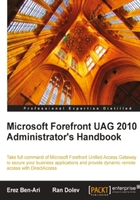
In the UAG world, the terms Application specific hostname applications (also known as AAM-like applications) and Portal hostname applications (also known as Non-AAM applications) are often used to describe two different categories of Web application templates. Originally, AAM (Alternate Access Mapping) was a very powerful feature of SharePoint which we will cover in a later section of this chapter. In the UAG world, this categorization is based on what public host name(s) can be used by users to access a UAG web application. If an application can be configured using its own specific public host name, which usually differs from the trunk's public host name, then this is referred to as an Application specific hostname application (or AAM application). On the other hand, if an application can't be configured with its own public host name and the only way to access it is by using the portal trunk's public host name, this is referred to as a Portal Hostname Application (or non-AAM application).
Let's consider an example of a company that is publishing a trunk with a public host name of portal.createhive.com.
This trunk publishes a group of web applications such as Finance, HR, Sales, and so on.
Users from the HR department only need to access their HR application and don't want to go through the hassle of looking for their application on the portal homepage to launch it.
If the HR application is published using the Application specific hostname template, then they can just directly use that application's specific public URL (for example, hr.createhive.com) and after a successful login they will be directly taken to the HR application, thus bypassing the portal home page or the trunk's Initial Internal Application.
However, for this to work, the application's public host name must be publicly resolvable to the same IP to which the trunk's public host name resolves. If the application is configured on an HTTPS trunk, then the SSL certificate used on the trunk should also include the application's public host name, otherwise browser clients will display a warning message and non-browser clients may even fail to work.
For the certificate requirements, either a SAN (Subject Alternative Name) certificate or a wildcard certificate can be used. Applications published using the portal hostname template use the portal trunk's host name and therefore rely upon the HAT mechanism (or Host Address Translation) which was discussed in Chapter 3. Since an Application specific hostname application doesn't rely on HAT, in some cases it is preferable, as some web content or applications do not handle the HAT process gracefully. For publishing a generic web application, we can either choose Other Web Application (application specific hostname), or Other Web Application (portal hostname). For those of you familiar with UAG's predecessors, IAG and e-Gap, the Other Web Application (portal hostname) template is similar to the Generic Web App template that was used in IAG and e-Gap.
In addition, with these older products, it was possible to publish applications that are accessible directly by using a "Basic" trunk. Basic trunks have been deprecated in UAG, but the Other Web Application (application specific hostname) template fulfils a similar function. If you are familiar with ISA or TMG Web Publishing rules, then you can also think of this template as using the Link Translation functionality of ISA/TMG instead of HAT. Examples of some of the other UAG application templates that use the same "application specific hostname" logic are Microsoft Office Communicator Web Access 2007, Microsoft Forefront Identity Manager 2010, Microsoft Exchange Server, Microsoft SharePoint Server 2010, and Microsoft Office SharePoint Server 2007. Portal hostname templates include all of the Built-in services applications, as well as Microsoft Dynamics CRM 4.0, Microsoft Office SharePoint Portal Server 2003. In addition, the web-services part of the Exchange Server 2003 template is also an application-specific hostname.